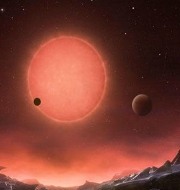NASA's Kepler Telescope finds 10 Earth-Like Planets
NASA’s Kepler Telescope has identified 10 Earth-like planets outside the solar system that are expected to host life due to their right size and temperature. This finding is a boost in the hope for life elsewhere.
Exoplanet: It is a planet that does not orbit the Sun and instead orbits a different star, stellar remnant, or brown dwarf. It is also termed as extrasolar planet.
After an extensive search carried out for four years, NASA’s Kepler space telescope has detected a total of 49 planets in the Goldilocks zone. This number is set to increase as Kepler telescope has so far looked only in one quarter of one percent of a galaxy that holds about 200 billion of stars.
Goldilocks Zone refers to a habitable zone where the temperature is neither too high nor too low.
NASA has announced the discovery of 10 planets as a part of 219 new planets identified by the Kepler telescope as part of the final batch of planets since Kepler was launched in 2009. Kepler’s main mission got ended in 2013 after two of its four wheels that control its orientation in space got failed.
Kepler has identified more than 4,000 planet candidates and confirmed more than half of them. The number of potentially habitable planets could be lot more as Kepler was only able to identify only those planets that move between the telescope vision and its star.
By using Kepler and other methods, scientists have discovered around 3,600 exoplanets and about 62 potentially habitable planets.
With the launch of James Webb Space Telescope (JWST) by NASA in 2018, chances of studying planets and detecting a familiar atmosphere will increase manifold. JWST will succeed the Hubble space telescope.
Kepler Space Telescope
Kepler Space Telescope (KST) is an unmanned space observatory launched in 2009 by National Aeronautics and Space Administration (NASA). It is tasked with determining how many Earth-like planets occur throughout the Milky Way galaxy. It has been designed for a statistical mission and not to probe into the environmental conditions of planets that exist in the so-called Goldilocks zone (Habitable zone) of their stars.
Month: Current Affairs - June, 2017


